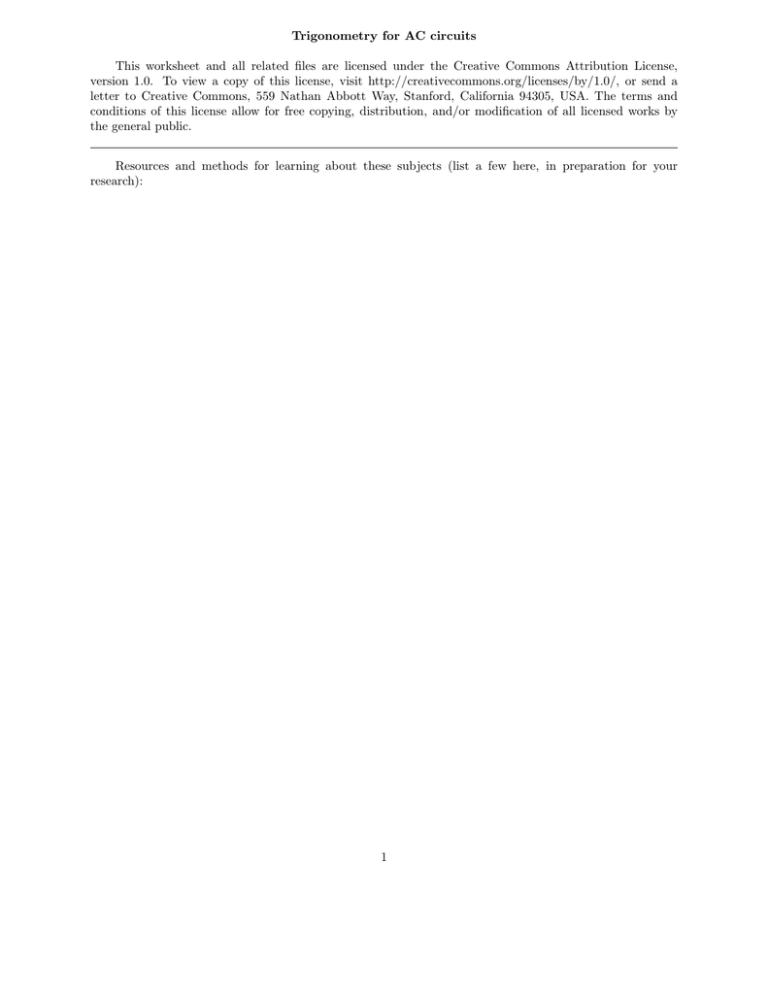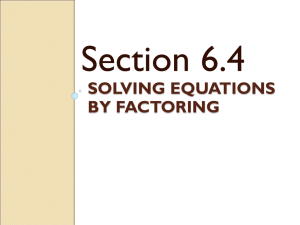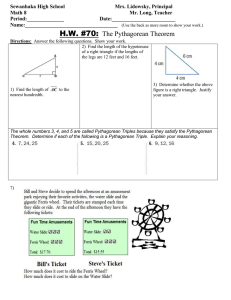Trigonometry for AC circuits This worksheet and all related
advertisement

Trigonometry for AC circuits This worksheet and all related files are licensed under the Creative Commons Attribution License, version 1.0. To view a copy of this license, visit http://creativecommons.org/licenses/by/1.0/, or send a letter to Creative Commons, 559 Nathan Abbott Way, Stanford, California 94305, USA. The terms and conditions of this license allow for free copying, distribution, and/or modification of all licensed works by the general public. Resources and methods for learning about these subjects (list a few here, in preparation for your research): 1 Questions Question 1 Evaluate the length of side x in this right triangle, given the lengths of the other two sides: x 8 6 file 03326 Question 2 Evaluate the length of side x in this right triangle, given the lengths of the other two sides: x 9 12 file 03327 Question 3 The Pythagorean Theorem is used to calculate the length of the hypotenuse of a right triangle given the lengths of the other two sides: e= C s nu ote B p Hy A "Right" angle = 90o Write the standard form of the Pythagorean Theorem, and give an example of its use. file 02102 2 Question 4 The Pythagorean Theorem is used to calculate the length of the hypotenuse of a right triangle given the lengths of the other two sides: e= C s nu ote B p Hy A "Right" angle = 90o Manipulate the standard form of the Pythagorean Theorem to produce a version that solves for the length of A given B and C, and also write a version of the equation that solves for the length of B given A and C. file 03114 Question 5 A rectangular building foundation with an area of 18,500 square feet measures 100 feet along one side. You need to lay in a diagonal run of conduit from one corner of the foundation to the other. Calculate how much conduit you will need to make the run: 18500 ft2 Co nd uit run 100 ft Also, write an equation for calculating this conduit run length (L) given the rectangular area (A) and the length of one side (x). file 03275 3 Question 6 Z X θ R Identify which trigonometric functions (sine, cosine, or tangent) are represented by each of the following ratios, with reference to the angle labeled with the Greek letter ”Theta” (Θ): X = R X = Z R = Z file 02084 Question 7 φ Z X R Identify which trigonometric functions (sine, cosine, or tangent) are represented by each of the following ratios, with reference to the angle labeled with the Greek letter ”Phi” (φ): R = X X = Z R = Z file 03113 4 Question 8 Trigonometric functions such as sine, cosine, and tangent are useful for determining the ratio of righttriangle side lengths given the value of an angle. However, they are not very useful for doing the reverse: calculating an angle given the lengths of two sides. Z X θ R Suppose we wished to know the value of angle Θ, and we happened to know the values of Z and R in this impedance triangle. We could write the following equation, but in its present form we could not solve for Θ: R Z The only way we can algebraically isolate the angle Θ in this equation is if we have some way to ”undo” the cosine function. Once we know what function will ”undo” cosine, we can apply it to both sides of the equation and have Θ by itself on the left-hand side. There is a class of trigonometric functions known as inverse or ”arc” functions which will do just that: ”undo” a regular trigonometric function so as to leave the angle by itself. Explain how we could apply an ”arc-function” to the equation shown above to isolate Θ. file 02086 cos Θ = Question 9 The impedance triangle is often used to graphically relate Z, R, and X in a series circuit: R Z Z∠θ X θ X R Unfortunately, many students do not grasp the significance of this triangle, but rather memorize it as a ”trick” used to calculate one of the three variables given the other two. Explain why a right triangle is an appropriate form to relate these variables, and what each side of the triangle actually represents. file 02076 5 Question 10 Use the ”impedance triangle” to calculate the impedance of this series combination of resistance (R) and inductive reactance (X): Z = ??? R = 500 Ω X = 375 Ω X = 375 Ω R = 500 Ω Explain what equation(s) you use to calculate Z. file 02081 Question 11 Students studying AC electrical theory become familiar with the impedance triangle very soon in their studies: Z X R What these students might not ordinarily discover is that this triangle is also useful for calculating electrical quantities other than impedance. The purpose of this question is to get you to discover some of the triangle’s other uses. Fundamentally, this right triangle represents phasor addition, where two electrical quantities at right angles to each other (resistive versus reactive) are added together. In series AC circuits, it makes sense to use the impedance triangle to represent how resistance (R) and reactance (X) combine to form a total impedance (Z), since resistance and reactance are special forms of impedance themselves, and we know that impedances add in series. List all of the electrical quantities you can think of that add (in series or in parallel) and then show how similar triangles may be drawn to relate those quantities together in AC circuits. file 02077 6 Question 12 Explain why the ”impedance triangle” is not proper to use for relating total impedance, resistance, and reactance in parallel circuits as it is for series circuits: This impedance triangle does not apply to parallel circuits, but only to series circuits! Z X X R (not equal to) R file 02078 Question 13 Examine the following circuits, then label the sides of their respective triangles with all the variables that are trigonometrically related in those circuits: file 03288 7 Question 14 Use a triangle to calculate the total voltage of the source for this series RC circuit, given the voltage drop across each component: VR = 3.2 V VR = 3.2 V VC = 1.8 V Vtotal Vtotal = ??? VC = 1.8 V Explain what equation(s) you use to calculate Vtotal , as well as why we must geometrically add these voltages together. file 02107 Question 15 Use the ”impedance triangle” to calculate the necessary resistance of this series combination of resistance (R) and inductive reactance (X) to produce the desired total impedance of 5.2 kΩ: Z = 5.2 kΩ R = ??? X = 1.5 kΩ X = 1.5 kΩ R = ??? Explain what equation(s) you use to calculate R, and the algebra necessary to achieve this result from a more common formula. file 02082 Question 16 Use the ”impedance triangle” to calculate the necessary reactance of this series combination of resistance (R) and inductive reactance (X) to produce the desired total impedance of 145 Ω: Z = 145 Ω R = 100 Ω X = ??? X = ??? R = 100 Ω Explain what equation(s) you use to calculate X, and the algebra necessary to achieve this result from a more common formula. file 02083 8 Question 17 Use the ”impedance triangle” to calculate the necessary reactance of this series combination of resistance (R) and capacitive reactance (X) to produce the desired total impedance of 300 Ω: R = 210 Ω R = 210 Ω Z = 300 Ω X = ??? X = ??? Explain what equation(s) you use to calculate X, and the algebra necessary to achieve this result from a more common formula. file 02092 Question 18 A series AC circuit contains 1125 ohms of resistance and 1500 ohms of reactance for a total circuit impedance of 1875 ohms. This may be represented graphically in the form of an impedance triangle: Z = 1875 Ω X = 1500 Ω θ R = 1125 Ω Since all side lengths on this triangle are known, there is no need to apply the Pythagorean Theorem. However, we may still calculate the two non-perpendicular angles in this triangle using ”inverse” trigonometric functions, which are sometimes called arcfunctions. Identify which arc-function should be used to calculate the angle Θ given the following pairs of sides: R and Z X and R X and Z Show how three different trigonometric arcfunctions may be used to calculate the same angle Θ. file 02085 9 Question 19 A series AC circuit exhibits a total impedance of 10 kΩ, with a phase shift of 65 degrees between voltage and current. Drawn in an impedance triangle, it looks like this: R 65o X Z = 10 kΩ We know that the sine function relates the sides X and Z of this impedance triangle with the 65 degree angle, because the sine of an angle is the ratio of opposite to hypotenuse, with X being opposite the 65 degree angle. Therefore, we know we can set up the following equation relating these quantities together: sin 65o = X Z Solve this equation for the value of X, in ohms. file 02088 Question 20 A series AC circuit exhibits a total impedance of 2.5 kΩ, with a phase shift of 30 degrees between voltage and current. Drawn in an impedance triangle, it looks like this: Z = 2.5 kΩ X o 30 R Use the appropriate trigonometric functions to calculate the equivalent values of R and X in this series circuit. file 02087 10 Question 21 A parallel AC circuit draws 8 amps of current through a purely resistive branch and 14 amps of current through a purely inductive branch: IR = 8 A θ IL = 14 A Itotal = ??? 8A 14 A Calculate the total current and the angle Θ of the total current, explaining your trigonometric method(s) of solution. file 02089 Question 22 A parallel AC circuit draws 100 mA of current through a purely resistive branch and 85 mA of current through a purely capacitive branch: Itotal = ??? IC = 85 mA IR = 100 mA θ IC = 85 mA IR = 100 mA Calculate the total current and the angle Θ of the total current, explaining your trigonometric method(s) of solution. file 02091 Question 23 A parallel RC circuit has 10 µS of susceptance (B). How much conductance (G) is necessary to give the circuit a (total) phase angle of 22 degrees? 22o G = ??? B = 10 µS G = ??? file 02090 11 B = 10 µS Answers Answer 1 x = 10 Answer 2 x = 15 Answer 3 I’ll let you research this one on your own! Follow-up question: identify an application in AC circuit analysis where the Pythagorean Theorem would be useful for calculating a circuit quantity such as voltage or current. Answer 4 Standard form of the Pythagorean Theorem: C= p A= p B= p A2 + B 2 Solving for A: C 2 − B2 Solving for B: C 2 − A2 Answer 5 Conduit run = 210 feet, 3.6 inches from corner to corner. Note: the following equation is not the only form possible for calculating the diagonal length. Do not be worried if your equation does not look exactly like this! √ x4 + A2 L= x 12 Answer 6 Z X θ R X Opposite = tan Θ = R Adjacent Opposite X = sin Θ = Z Hypotenuse R Adjacent = cos Θ = Z Hypotenuse Answer 7 φ Z X R Opposite R = tan φ = X Adjacent X Adjacent = cos φ = Z Hypotenuse Opposite R = sin φ = Z Hypotenuse 13 Answer 8 R Z cos Θ = Original equation . . . applying the ”arc-cosine” function to both sides . . . arccos (cos Θ) = arccos Θ = arccos R Z R Z Answer 9 Each side of the impedance triangle is actually a phasor (a vector representing impedance with magnitude and direction): Zseries ZC or ZL ZR Since the phasor for resistive impedance (ZR ) has an angle of zero degrees and the phasor for reactive impedance (ZC or ZL ) either has an angle of +90 or -90 degrees, the phasor sum representing total series impedance will form the hypotenuse of a right triangle when the first to phasors are added (tip-to-tail). Follow-up question: as a review, explain why resistive impedance phasors always have an angle of zero degrees, and why reactive impedance phasors always have angles of either +90 degrees or -90 degrees. Answer 10 Z = 625 Ω, as calculated by the Pythagorean Theorem. 14 Answer 11 Electrical quantities that add: • • • • • Series impedances Series voltages Parallel admittances Parallel currents Power dissipations I will show you one graphical example of how a triangle may relate to electrical quantities other than series impedances: Admittances add in parallel Y B G Answer 12 Impedances do not add in parallel. Follow-up question: what kind of a triangle could be properly applied to a parallel AC circuit, and why? Answer 13 YT IL IT L BL R ZT VR VR R YT IC IT XC R XL R VC VT VL VT G IR C ZT L C R BC R IR 15 G Answer 14 Vtotal = 3.672 volts, as calculated by the Pythagorean Theorem Answer 15 R = 4.979 kΩ, as calculated by an algebraically manipulated version of the Pythagorean Theorem. Answer 16 X = 105 Ω, as calculated by an algebraically manipulated version of the Pythagorean Theorem. Answer 17 X = 214.2 Ω, as calculated by an algebraically manipulated version of the Pythagorean Theorem. Answer 18 arccos R = 53.13o Z arctan X = 53.13o R arcsin X = 53.13o Z Challenge question: identify three more arcfunctions which could be used to calculate the same angle Θ. Answer 19 X = 9.063 kΩ Answer 20 R = 2.165 kΩ X = 1.25 kΩ Answer 21 Itotal = 16.12 amps Θ = 60.26o (negative, if you wish to represent the angle according to the standard coordinate system for phasors). Follow-up question: in calculating Θ, it is recommended to use the arctangent function instead of either the arcsine or arc-cosine functions. The reason for doing this is accuracy: less possibility of compounded error, due to either rounding and/or calculator-related (keystroke) errors. Explain why the use of the arctangent function to calculate Θ incurs less chance of error than either of the other two arcfunctions. Answer 22 Itotal = 131.2 mA Θ = 40.36o Follow-up question: in calculating Θ, it is recommended to use the arctangent function instead of either the arcsine or arc-cosine functions. The reason for doing this is accuracy: less possibility of compounded error, due to either rounding and/or calculator-related (keystroke) errors. Explain why the use of the arctangent function to calculate Θ incurs less chance of error than either of the other two arcfunctions. 16 Answer 23 G = 24.75 µS Follow-up question: how much resistance is this, in ohms? 17 Notes Notes 1 This question is a straight-forward test of students’ ability to identify and apply the 3-4-5 ratio to a right triangle. Notes 2 This question is a straight-forward test of students’ ability to identify and apply the 3-4-5 ratio to a right triangle. Notes 3 The Pythagorean Theorem is easy enough for students to find on their own that you should not need to show them. A memorable illustration of this theorem are the side lengths of a so-called 3-4-5 triangle. Don’t be surprised if this is the example many students choose to give. Notes 4 The Pythagorean Theorem is easy enough for students to find on their own that you should not need to show them. A memorable illustration of this theorem are the side lengths of a so-called 3-4-5 triangle. Don’t be surprised if this is the example many students choose to give. Notes 5 Determining the necessary length of conduit for this question involves both the Pythagorean theorem and simple geometry. Most students will probably arrive at this form for their diagonal length equation: s 2 A L = x2 + x While this is perfectly correct, it is an interesting exercise to have students convert the equation from this (simple) form to that given in the answer. It is also a very practical question, as equations given in reference books do not always follow the most direct form, but rather are often written in such a way as to look more esthetically pleasing. The simple and direct form of the equation shown here (in the Notes section) looks ”ugly” due to the fraction inside the radicand. Notes 6 Ask your students to explain what the words ”hypotenuse”, ”opposite”, and ”adjacent” refer to in a right triangle. Notes 7 Ask your students to explain what the words ”hypotenuse”, ”opposite”, and ”adjacent” refer to in a right triangle. Notes 8 I like to show the purpose of trigonometric arcfunctions in this manner, using the cardinal rule of algebraic manipulation (do the same thing to both sides of an equation) that students are familiar with by now. This helps eliminate the mystery of arcfunctions for students new to trigonometry. Notes 9 The question is sufficiently open-ended that many students may not realize exactly what is being asked until they read the answer. This is okay, as it is difficult to phrase the question in a more specific manner without giving away the answer! 18 Notes 10 Be sure to have students show you the form of the Pythagorean Theorem, rather than showing them yourself, since it is so easy for students to research on their own. Notes 11 It is very important for students to understand that the triangle only works as an analysis tool when applied to quantities that add. Many times I have seen students try to apply the Z-R-X impedance triangle to parallel circuits and fail because parallel impedances do not add. The purpose of this question is to force students to think about where the triangle is applicable to AC circuit analysis, and not just to use it blindly. The power triangle is an interesting application of trigonometry applied to electric circuits. You may not want to discuss power with your students in great detail if they are just beginning to study voltage and current in AC circuits, because power is a sufficiently confusing subject on its own. Notes 12 Trying to apply the Z-R-X triangle directly to parallel AC circuits is a common mistake many new students make. Key to knowing when and how to use triangles to graphically depict AC quantities is understanding why the triangle works as an analysis tool and what its sides represent. Notes 13 This question asks students to identify those variables in each circuit that vectorially add, discriminating them from those variables which do not add. This is extremely important for students to be able to do if they are to successfully apply ”the triangle” to the solution of AC circuit problems. Note that some of these triangles should be drawn upside-down instead of all the same as they are shown in the question, if we are to properly represent the vertical (imaginary) phasor for capacitive impedance and for inductor admittance. However, the point here is simply to get students to recognize what quantities add and what do not. Attention to the direction (up or down) of the triangle’s opposite side can come later. Notes 14 Be sure to have students show you the form of the Pythagorean Theorem, rather than showing them yourself, since it is so easy for students to research on their own. Notes 15 Be sure to have students show you the form of the Pythagorean Theorem, rather than showing them yourself, since it is so easy for students to research on their own. Notes 16 Be sure to have students show you the form of the Pythagorean Theorem, rather than showing them yourself, since it is so easy for students to research on their own. Notes 17 Be sure to have students show you the form of the Pythagorean Theorem, rather than showing them yourself, since it is so easy for students to research on their own. Notes 18 Some hand calculators identify arc-trig functions by the letter ”A” prepending each trigonometric abbreviation (e.g. ”ASIN” or ”ATAN”). Other hand calculators use the inverse function notation of a -1 exponent, which is not actually an exponent at all (e.g. sin−1 or tan−1 ). Be sure to discuss function notation on your students’ calculators, so they know what to invoke when solving problems such as this. 19 Notes 19 Ask your students to show you their algebraic manipulation(s) in setting up the equation for evaluation. Notes 20 There are a few different ways one could solve for R and X in this trigonometry problem. This would be a good opportunity to have your students present problem-solving strategies on the board in front of class so everyone gets an opportunity to see multiple techniques. Notes 21 The follow-up question illustrates an important principle in many different disciplines: avoidance of unnecessary risk by choosing calculation techniques using given quantities instead of derived quantities. This is a good topic to discuss with your students, so make sure you do so. Notes 22 The follow-up question illustrates an important principle in many different disciplines: avoidance of unnecessary risk by choosing calculation techniques using given quantities instead of derived quantities. This is a good topic to discuss with your students, so make sure you do so. Notes 23 Ask your students to explain their method(s) of solution, including any ways to double-check the correctness of the answer. 20



